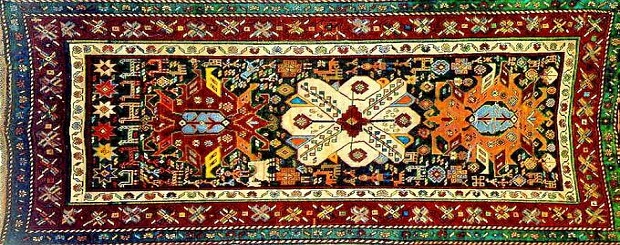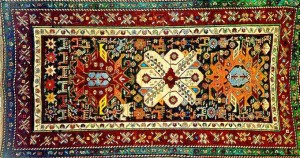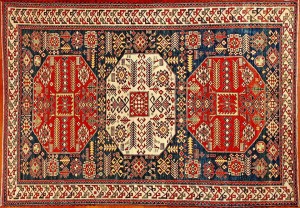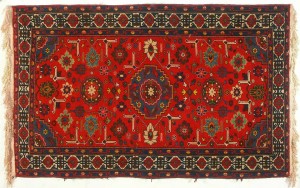
ARMENIAN CARPETS | HAYASTAN – ARMENIA
The complex history of Armenian weaving and needlework was acted out in the Near East, a vast, ancient, and ethnically diverse region. Few are the people who, like the Armenians, can boast of a continuous and consistent record of fine textile production from the 1st millennium BC to the present. Armenians today are blessed by the diversity and richness of a textile heritage passed on by thirty centuries of diligent practice.
Armenian carpets are unique “texts” composed of the ornaments where sacred symbols reflect the beliefs and religious notions of the ancient ancestors of the Armenians that have reached us from the depth of centuries. The Armenian carpet and rug weavers preserved strictly the traditions.
The imitation and consistent presentation of one and the same ornament-ideogram in the unlimited number of the variations of styles and colors, as well as type of color dye utilized, contain the basis for the creation of any new Armenian carpet, while always keeping the historic tradition alive.
ARMENIAN CARPETS: THE ORIGIN OF THE NAME




Carpets were woven in all the provinces of historical Armenia.
Two of the most frequently used terms to designate woven woolen floor coverings emanate directly from the Armenian experience: carpet and kali/khali (*Khali, which is derived from the Persian word for carpet -قالی). The term “kapert” (Armenian: կապերտ), formed of root “kap” (Armenian: կապ) that means “knot”, later to become “karpet” (Armenian: կարպետ) in colloquial Armenian, is used in the 5th-century Armenian translation of the Bible (Matthew 9:16 and Mark 2:21).
There is also a supposition that long ago the Armenian word “Bazmakan” (“Բազմական”) (bazmel / բազմել– to sit, sitting) was used for ‘piled weavings’–carpets.
On the territory of Armenia the earliest woven specimens have been discovered in the Artik burial ground ( 3rd millennium B.C) and Karmir Blur (7th millennium B.C.).
The Persian world *Khali” (carpet), also sometime used by Armenians, is derived from the city of Theodosiopolis-Karin-Erzerum, known to the Arabs as Qali-qala from the Armenian “Karnoy k‘aghak”, the “city of Karin”.
The name “Erzerum” itself, as is well known, is of Armenian origin from the usage Artzen ar-Rum. This latter term came into being after the destruction of the important Armenian commercial center of Artzen, 15 kilometers east of Theodosiopolos-Karin, by the Seljuks in 1041 after which the inhabitants fled to Karin, then in Rum, that is in Byzantine territory, renaming it Artzen in Rum or Arzerum/Erzerum/Erzurum.
AFTER ARMENIA DECLARED ITSELF AS THE FIRST CHRISTIAN STATE
After Armenia declared itself as the first Christian state in 301 AD, carpet making took on a decidedly Christian art form and identity. This art form existed continuously unaltered until the Armenian Genocide. By the Middle Ages, Armenia was a major exporter of carpets to as far away places as China.
In many Medieval Chinese artworks for example, carpets were depicted in which the designs were typically that of Armenian carpets with some even depicting clear Christian crosses.
The art of the Armenian carpet during this period evolved alongside Armenian church architecture, Armenian cross-stones (Khachkars) and illuminated manuscript art, with typical rug motifs using the same elements of these designs. The cruciform with its variations would eventually come to dominate Armenian carpet designs.
The Armenian tradition of carpet weaving and artistry has also played a major role in historical aspects of Armenian life. It has helped Armenians utilize rugs and rug weaving to attain their traditions during consecutive and different Armenian Kingdoms and under the yoke of diverse conquering empires throughout their long and ancient history.
The craft of carpet weaving, has also been instrumental in helping Armenians overcome and persevere near annihilation and be reborn like the phoenix rising from the ashes, in refugee camps in the aftermath of the Armenian Genocide 1915, perpetrated by the Ottoman Empire– to the present day condition, within the Armenian Diaspora, and the Republics of Armenia and Artsakh.
Artsakh (Karabakh) carpets differ from the ones in other Provinces of Armenia; One of the most notable symbols of Artsakh carpets is the medallion. This symbol, most likely, originates from the ‘cote of arms’ of Armenian princes and dynasties. Another common symbol is a crowned bull. In ancient times the bull was a revered animal. One of the largest and most sophisticated of Artsakh carpets, is the famous “Goarkarpet” woven in Artsakh in 1700.
***
Carpets in Armenia were made of wool, silk, cotton, and linen. For coloring only natural dyes were used. Ornaments and themes used in the design of Armenian carpets are diverse. Great popularity had the ones depicting the tree of life, as well as carpets depicting geometric designs with floral decors and images of birds and horses (17 cent.) “An eagle” and “a cross” are other distinctly popular medieval symbols of Armenian national carpets.
Armenian carpets owed their high-quality also to the wool of ”Balbas” sheep that were raised in the Armenian Highlands. Historical facts and various sources tell us about wool’s unique quality and gloss. The Angora goat wool was widely popular in Western Armenia. In the historical regions of Armenia where cotton and silk thread production was developed, both cotton and silk thread were also used in carpet weaving. In particular, cotton and silk were popular in the southern parts of Artsakh, Meghri and Nakhichevan; silk was used in Kharberd; and cotton – in the eastern regions of Vaspurakan and Ararat valley.
The red color of Armenian carpets was made from “vordan karmir” or “worm’s red” dyestuff. The fact that “vordan karmir” dye was used in making of the oldest surviving carpet “Pazyryk” is a perfect example of this and has already been proven by the scientists in particular by I. Rudenko. “Pazyryk” dates back to the 5-4th centuries B.C. and may be viewed nowadays at the Hermitage museum. Arab historians noted that Armenian carpets were the most valuable because they were made from high-quality wool and were dyed with durable “vordan karmir” pigment. This also explains why Armenian carpets were known in the Arab world as “kirmiz” (red).
Sources & References:
https://aratta.wordpress.com/…/the-armenian-carpet-and-its…/
http://eltravelclub.am/…/culture-of-ar…/art-and-architecture
https://en.wikipedia.org/wiki/Armenian_carpet
~ Art of Armenia ~
https://www.facebook.com/Art.of.Armenia/
